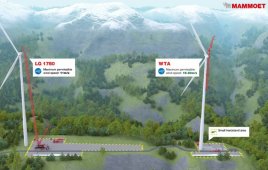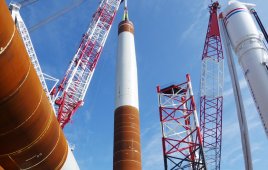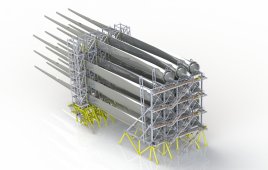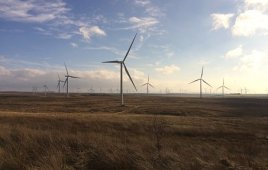An idea originally developed to increase lift in slow moving aircraft wings and simplify helicopter rotors may soon improve the efficiency of wind turbine rotors and possibly reduce their cost of manufacturing. This “circulation control” aerodynamic technology could let wind turbines produce significantly more power than current devices at the same wind speed, 30 to 40% more by some calculations.
Circulation control techniques blows compressed air from slots on the trailing edges of wings or hollow blades to change their aerodynamic properties. In aircraft, circulation-control wings improve lift, letting aircraft fly at much lower speeds, as well as take off and land in shorter distances. In helicopter rotor blades, the technique, also called “circulation control rotor”, simplifies the rotor and its controls, and produces more lift.

The airfoil is of a NASA/GTRI 2D CFD model for validation, not necessarily a turbine rotor cross section. Slots could be at the leading or trailing edges, depending on a required effect. A few slot dimensions are shown. Source: NASA.
Research aimed at adapting circulation control technology to wind turbine blades will be conducted by a California-based PAX Streamline, in collaboration with the Georgia Institute of Technology. The two-year project will lead to construction of a demonstration pneumatic wind turbine with support from a $3 million grant from the Advanced Research Projects Agency-Energy (ARPA-E) the federal energy research and development organization.
“Our goal will be to make generation of electricity from wind turbines less expensive by eliminating the need for the complex blade shapes and mechanical control systems used in existing turbines,” said Robert J. Englar, principal research engineer at the Georgia Tech Research Institute (GTRI).
“Because these new blades would operate effectively at lower wind speeds, we could potentially open new geographic areas to wind turbine use. Together, these advances could significantly expand the generation of electricity from wind power in the United States.”
The ARPA-E project will apply the technique to controlling the aerodynamic properties of wind turbine blades, which now must be made in complicated shapes and controlled by complex control mechanisms to extract optimal power from the wind.
“The wind speed at which these turbines would begin operating will be much lower than with existing blades,” said Englar. “Location that wind maps have previously indicated would not be suitable locations for wind turbines may now be useful. The blown technology should also allow safe operation at higher wind speeds and in wind gusts that would cause existing turbines to be shut down to prevent damage.
“Because they would produce more aerodynamic force, torque, and power than comparable blades, these blown structures being developed by Georgia Tech and PAX could also allow a reduction in the size of the wind turbines.
“If you need a specific amount of wind force and torque to generate electricity, we could get that force and torque from a smaller blade area because we’d have more powerful lifting surfaces,” says Englar.
A major question awaiting study is how much energy will be required to produce the compressed air the blown blades need to operate. Preliminary studies done by Professor Lakshmi Sankar in Georgia Tech’s School of Aerospace Engineering suggest that wind turbines with the blown blades could produce 30 to 40% more power than conventional turbines at the same wind speed, even when the energy required to produce the compressed air is subtracted from the total energy production.
The new turbine blades will be developed at GTRI’s low-speed wind tunnel research facility located in Cobb County, north of Atlanta.
Officials of PAX Streamline see the circulation control technology as key to development of a new generation of turbines that could significantly lower the cost of producing electricity from the wind. “This is a significant validation of our established turbine R&D,” said PAX CEO John Webley. “With this grant, we can rapidly accelerate our research program and, within the next two years, deploy a prototype wind turbine which demonstrates our game-changing technology.”
Filed Under: Blades, Construction





Interesting but the Betz limit still applies. I don’t see how you could extract more energy from the available wind, even with this ‘technology’.
Mr. Loritz:
You’re quite right. I don’t think developers claim to exceed the Betz limit.
That idea was proposed in another story. The engineer working on the equipment to do so was planning on removing heat from the passing air, enough to exceed the energy level predicted by the Betz limit. I believe it to be theoretically possible. A working prototype of such a device will be interesting proof.
Paul
Paul